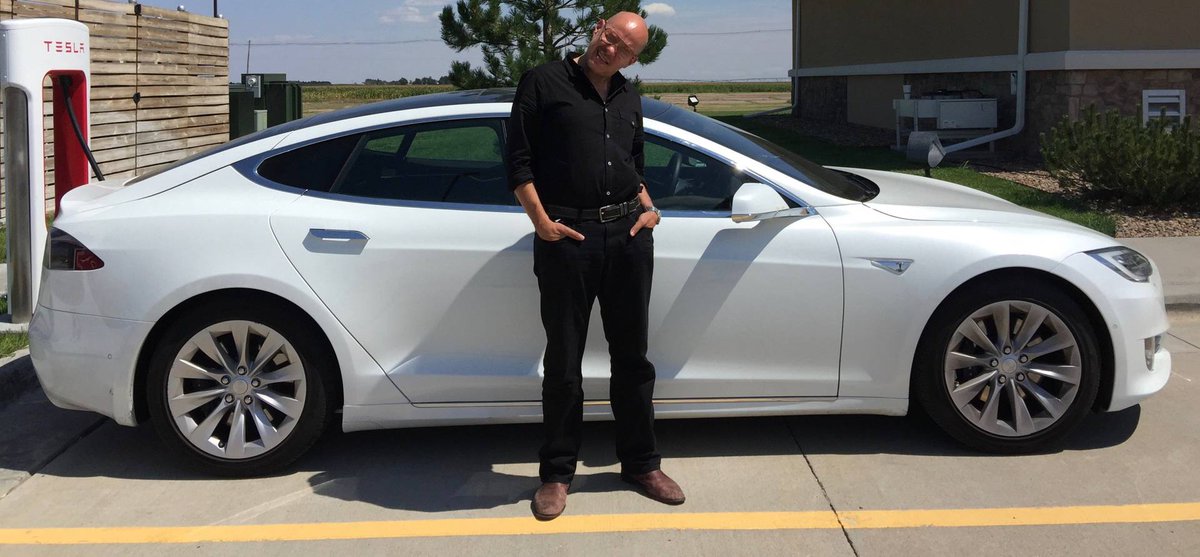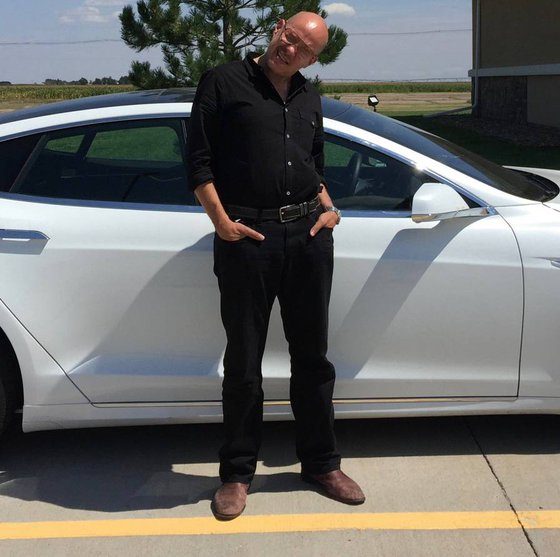

News
Tesla’s self-driving CA to NY “Cannonball” run needs Alex Roy
Alex Roy of Cannonball Run fame made his case for why Tesla CEO Elon Musk should put him in the first fully autonomous Tesla, set to take stage when it drives cross-country without human input later this year.
To establish a firm foundation for his case, Roy backs his story on The Drive with history of the epic yet controversial cross-country speed route that is the Cannonball Run. The race has a long history of disputed claims based on lack of evidence due to the inability of racers to provide sufficient corroborating evidence. VIN verifications, multiple eye witnesses and fuel receipts evolved to become supporting evidence needed in the loosely defined rules for the Cannonball Run. Roy notes that “extraordinary claims require extraordinary evidence” as the capstone for his claim.
If Tesla is going to make the truly historic claim of being the first vehicle to drive autonomously from a California parking lot to a parking lot in New York as stated by Musk earlier this year, Roy believes it will require an equal amount of evidence. How will the public know that nobody touched the steering wheel while navigating to the fourth or fourteenth Supercharger on the route? Will the public be able to trust that the run actually happened without a full and complete set of incontrovertible evidence?
Roy posits that because the run Tesla will make is not simply a timed drive across the nation but truly a technological feat that seeks to establish a basis of trust with its customers, Tesla must establish a body of evidence that is irrefutable. The stakes are too high and, perhaps more importantly, the technology and skills to implement it exist.
Finally, Alex makes the case that in the very small subset of journalists and auto enthusiasts qualified to participate in the historic event, Roy is the most capable and qualified given his long history with autos, the Cannonball Run and autonomous driving. In terms of qualifications, it is clear that Roy is in a class apart. He’s in an elite club of extreme auto racers that are just crazy enough to attempt breaking long held records held by generations past.
The challenge with this particular run is that it is not a Cannonball Run style event. It will be going cross-country but not for time and Roy acknowledges that. Tesla has never been a company to sensationalize the work it does or the milestones it achieves. Major updates are typically rolled out to stores with media left to figure out what happened, where, to whom and how much it will cost without the typical press releases or media events. Sure, it hosts events for major product releases like the Model 3 reveal last year, but it has never aimed to be a hype factory.
Whether or not Tesla takes Roy up on his offer or plea to be the independent observer and counselor in the first vehicle of any kind to drive coast to coast fully autonomously is something we will see in due time, but another outcome is fully possible. If Tesla is so confident in its vast array of on-board camera and sensor technology – enough to be comfortable sending humans hurtling down the highway in one of its vehicles unassisted – it is also possible if not likely that it is already capturing and storing all of that sensor metadata.
With granular GPS breadcrumb data supported by feeds from the integrated camera array and a bevy of radar metadata, could it already prove beyond a shadow of a doubt that it performed the trip cross country? And if someone is going to be in the car, Roy is the clear choice as he has the know-how to cover the run and an inhuman ability to wait hours and hours longer than is likely healthy to use the bathroom.

Elon Musk
Elon Musk and Tesla AI Director share insights after empty driver seat Robotaxi rides
The executives’ unoccupied tests hint at the rapid progress of Tesla’s unsupervised Robotaxi efforts.

Tesla CEO Elon Musk and AI Director Ashok Elluswamy celebrated Christmas Eve by sharing personal experiences with Robotaxi vehicles that had no safety monitor or occupant in the driver’s seat. Musk described the system’s “perfect driving” around Austin, while Elluswamy posted video from the back seat, calling it “an amazing experience.”
The executives’ unoccupied tests hint at the rapid progress of Tesla’s unsupervised Robotaxi efforts.
Elon and Ashok’s firsthand Robotaxi insights
Prior to Musk and the Tesla AI Director’s posts, sightings of unmanned Teslas navigating public roads were widely shared on social media. One such vehicle was spotted in Austin, Texas, which Elon Musk acknowleged by stating that “Testing is underway with no occupants in the car.”
Based on his Christmas Eve post, Musk seemed to have tested an unmanned Tesla himself. “A Tesla with no safety monitor in the car and me sitting in the passenger seat took me all around Austin on Sunday with perfect driving,” Musk wrote in his post.
Elluswamy responded with a 2-minute video showing himself in the rear of an unmanned Tesla. The video featured the vehicle’s empty front seats, as well as its smooth handling through real-world traffic. He captioned his video with the words, “It’s an amazing experience!”
Towards Unsupervised operations
During an xAI Hackathon earlier this month, Elon Musk mentioned that Tesla owed be removing Safety Monitors from its Robotaxis in Austin in just three weeks. “Unsupervised is pretty much solved at this point. So there will be Tesla Robotaxis operating in Austin with no one in them. Not even anyone in the passenger seat in about three weeks,” he said. Musk echoed similar estimates at the 2025 Annual Shareholder Meeting and the Q3 2025 earnings call.
Considering the insights that were posted Musk and Elluswamy, it does appear that Tesla is working hard towards operating its Robotaxis with no safety monitors. This is quite impressive considering that the service was launched just earlier this year.
Elon Musk
Starlink passes 9 million active customers just weeks after hitting 8 million
The milestone highlights the accelerating growth of Starlink, which has now been adding over 20,000 new users per day.

SpaceX’s Starlink satellite internet service has continued its rapid global expansion, surpassing 9 million active customers just weeks after crossing the 8 million mark.
The milestone highlights the accelerating growth of Starlink, which has now been adding over 20,000 new users per day.
9 million customers
In a post on X, SpaceX stated that Starlink now serves over 9 million active users across 155 countries, territories, and markets. The company reached 8 million customers in early November, meaning it added roughly 1 million subscribers in under seven weeks, or about 21,275 new users on average per day.
“Starlink is connecting more than 9M active customers with high-speed internet across 155 countries, territories, and many other markets,” Starlink wrote in a post on its official X account. SpaceX President Gwynne Shotwell also celebrated the milestone on X. “A huge thank you to all of our customers and congrats to the Starlink team for such an incredible product,” she wrote.
That growth rate reflects both rising demand for broadband in underserved regions and Starlink’s expanding satellite constellation, which now includes more than 9,000 low-Earth-orbit satellites designed to deliver high-speed, low-latency internet worldwide.
Starlink’s momentum
Starlink’s momentum has been building up. SpaceX reported 4.6 million Starlink customers in December 2024, followed by 7 million by August 2025, and 8 million customers in November. Independent data also suggests Starlink usage is rising sharply, with Cloudflare reporting that global web traffic from Starlink users more than doubled in 2025, as noted in an Insider report.
Starlink’s momentum is increasingly tied to SpaceX’s broader financial outlook. Elon Musk has said the satellite network is “by far” the company’s largest revenue driver, and reports suggest SpaceX may be positioning itself for an initial public offering as soon as next year, with valuations estimated as high as $1.5 trillion. Musk has also suggested in the past that Starlink could have its own IPO in the future.
News
NVIDIA Director of Robotics: Tesla FSD v14 is the first AI to pass the “Physical Turing Test”
After testing FSD v14, Fan stated that his experience with FSD felt magical at first, but it soon started to feel like a routine.

NVIDIA Director of Robotics Jim Fan has praised Tesla’s Full Self-Driving (Supervised) v14 as the first AI to pass what he described as a “Physical Turing Test.”
After testing FSD v14, Fan stated that his experience with FSD felt magical at first, but it soon started to feel like a routine. And just like smartphones today, removing it now would “actively hurt.”
Jim Fan’s hands-on FSD v14 impressions
Fan, a leading researcher in embodied AI who is currently solving Physical AI at NVIDIA and spearheading the company’s Project GR00T initiative, noted that he actually was late to the Tesla game. He was, however, one of the first to try out FSD v14.
“I was very late to own a Tesla but among the earliest to try out FSD v14. It’s perhaps the first time I experience an AI that passes the Physical Turing Test: after a long day at work, you press a button, lay back, and couldn’t tell if a neural net or a human drove you home,” Fan wrote in a post on X.
Fan added: “Despite knowing exactly how robot learning works, I still find it magical watching the steering wheel turn by itself. First it feels surreal, next it becomes routine. Then, like the smartphone, taking it away actively hurts. This is how humanity gets rewired and glued to god-like technologies.”
The Physical Turing Test
The original Turing Test was conceived by Alan Turing in 1950, and it was aimed at determining if a machine could exhibit behavior that is equivalent to or indistinguishable from a human. By focusing on text-based conversations, the original Turing Test set a high bar for natural language processing and machine learning.
This test has been passed by today’s large language models. However, the capability to converse in a humanlike manner is a completely different challenge from performing real-world problem-solving or physical interactions. Thus, Fan introduced the Physical Turing Test, which challenges AI systems to demonstrate intelligence through physical actions.
Based on Fan’s comments, Tesla has demonstrated these intelligent physical actions with FSD v14. Elon Musk agreed with the NVIDIA executive, stating in a post on X that with FSD v14, “you can sense the sentience maturing.” Musk also praised Tesla AI, calling it the best “real-world AI” today.








